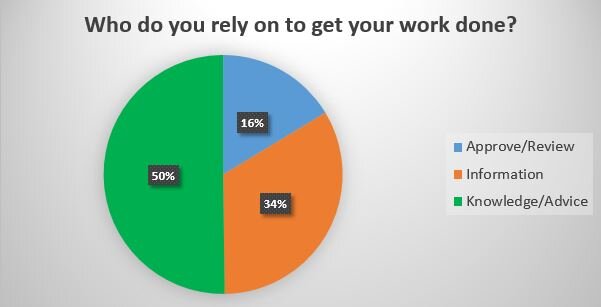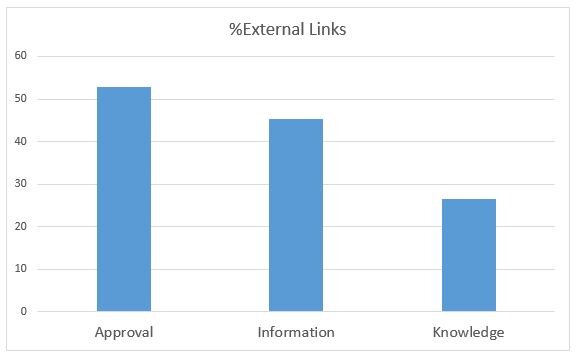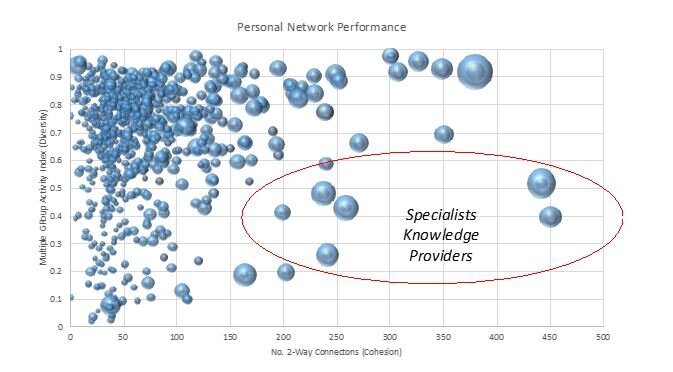Are we Getting Closer to True Knowledge Sharing Systems?
First generation knowledge management (KM) systems were essentially re-labelled content stores. Labelling such content as ‘knowledge’ did much to discredit the whole Knowledge Management movement of the 1990s. During this time, I commonly referred to knowledge management systems as needing to comprise both “collections and connections”, but we had forgotten about the “connections”. This shortcoming was addressed with the advent of Enterprise Social Networking (ESN) systems like Yammer, Jive, IBM Connect and now Workplace from Facebook. So now we do have both collections and connections. But do we now have true knowledge sharing?
Who do we Rely on for Knowledge Based Support?
A common occupation for KM professionals is to try and delineate a boundary between information, that can be effectively managed in an information store, and knowledge, which is implicitly and tacitly held by individuals. Tacit knowledge, arguably, can only be shared through direct human interaction. In our Social Network Analysis (SNA) consulting work we regularly surveyed staff on who they relied on to get their work done. We stumbled on the idea of asking them to qualify their selections by choosing only one of:
They review and approve my work (infers a line management connection)
They provide information that I need (infers an information brokering connection)
They provide advice to help me solve difficult problems (infers a knowledge based connection)
The forced choice was key. It proved to be a great way of delineating the information brokers from the true knowledge providers and the pure line managers. When we created our ‘top 10 lists’ for each role, there was regularly very little overlap. For organisations, the critical value in these nominations is that the knowledge providers are the hardest people to replace, and therefore it is critical to know who they are. And who they are, is not always apparent to line management!
So how do staff distribute their connections needs amongst line managers, information brokers and knowledge providers? We collated the results of several organisational surveys, comprising over 35,000 nominations, using this identical question, and came up with the following:
With 50% of the nominations, the results reinforce the perception that knowledge holders are critical to any organisation.
What do Knowledge Providers Look Like?
So what is special about these peer identified knowledge providers? Are they the ‘wise owls’ of the organisation, with long experiences spanning many different areas? Are they technical specialists with deep knowledge about fairly narrow areas? We took one organisation’s results and assessed the leaders of each of the categories of Approve/review, Information and Knowledge/Advice looking for their breadth or diversity of influence. We measured this by calculating the % of connections, nominating them as an important resource, that came from outside their home business unit. Here are the results:
As we might anticipate, the inferred line management had the broadest diversity of influence. The lowest % being for the knowledge providers, suggests that it’s not the broadly experienced wise old owls, but those specialising in relatively narrow areas, where people are looking for knowledge/advice from.
Implications for Knowledge Sharing Systems
We have previously written about our Network Performance Framework, where performance is judged based on how individuals, groups, or even full organisations balance diversity and cohesion in their internal networks:
The above framework identifies ‘Specialists’ as those who have limited diversity but a strong following i.e. many nominations as a key resource. These appear to be the people identifying as critical knowledge providers.
The question now is to whether online systems are identifying and supporting specialists to share their knowledge? At SWOOP we have aimed to explore this question initially by using a modification of this performance framework on interactions data drawn from Microsoft Yammer installations:
We measured each individual’s diversity of connections (y-axis) from their activities across multiple Yammer groups. The x-axis identifies the number of reciprocated connections an individual has i.e. stronger ties, together with the size of their personal network, identified by the size of the bubble representing them. We can see here that we have been able to identify those selected few ‘Specialists’ in the lower diversity/stronger cohesion quadrant, from their Yammer activities. These specialists all have relatively large networks of influence.
What we might infer from the above analysis is that an ESN like Yammer can identify those most prospective knowledge providers that staff are seeking out for knowledge transfer. But the bigger question is whether actual knowledge transfer can happen solely through an ESN like Yammer?
Is Having Systems that Provide Connections and Collections Enough to Ensure Effective Knowledge Sharing?
The knowledge management and social networking research is rich with studies addressing the question of how social network structure impacts on effective knowledge sharing. While an exhaustive literature review is beyond the scope of this article, for those inclined, this article on Network Structure and Knowledge Transfer: The Effects of Cohesion and Range is representative. Essentially this research suggests that ‘codified’ knowledge is best transferred through weak ties, but tacit knowledge sharing requires strong tie relationships. Codified knowledge commonly relates to stored artefacts like best practice procedural documents, lessons learned libraries, cases studies and perhaps even archived online Q&A forums. Tacit knowledge by definition cannot be codified, and therefore can only be shared through direct personal interactions.
I would contend that relationships formed solely through ESN interactions, or in fact any electronic systems like chat, email, etc. would be substantially weaker than those generated through regular face to face interactions. Complex tacit knowledge would need frequent and regular human interactions. It is unlikely that the strength of tie required, to effectively share complex knowledge, can be achieved solely through commonly available digital systems. What the ESN’s can do effectively is to help identify who you should be targeting as a knowledge sharing partner. Of course this situation is changing rapidly, as more immersive collaboration experiences are developed. But right now for codified knowledge, yes; for tacit knowledge, not yet.
(image credit: https://mariaalbatok.wordpress.com/2015/02/10/religious-knowledge-systems/)





